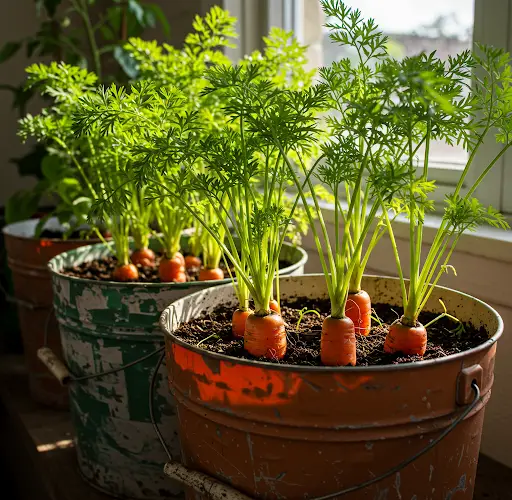Brilliant Idea: How to Grow Carrots at Home for a Bountiful Harvest
Carrots are a staple in kitchens around the world. Crisp, sweet, and full of nutrients, they’re an excellent addition to salads, soups, and juices. The great news is—you don’t need a large garden or farm to grow them. With the right technique, you can grow carrots at home and harvest plenty of healthy, well-formed roots, even in limited space.
This guide will walk you through an easy, space-saving method to grow carrots at home. Whether you have a backyard, a balcony, or just a sunny corner, you can successfully grow carrots and enjoy a steady supply of fresh produce.
Why Grow Carrots at Home?
There are several advantages to growing your own carrots:
-
Better flavor – Homegrown carrots are often sweeter and more flavorful than store-bought ones.
-
Pesticide-free – You have complete control over what goes into the soil.
-
Freshness – Harvest them just before eating for the best taste and nutrition.
-
Space-saving – Carrots grow well in containers and small raised beds.
-
Fun and rewarding – It’s exciting to pull fresh carrots out of the soil you prepared.
What You’ll Need
To grow carrots successfully at home, you’ll need the following:
-
Carrot seeds – Choose a variety suited for containers (like ‘Paris Market’, ‘Little Finger’, or ‘Nantes’).
-
Containers or grow bags – At least 10–12 inches deep with drainage holes.
-
Loose, well-draining soil – Sandy loam mixed with compost is ideal.
-
Watering can or spray nozzle – For gentle and consistent watering.
-
Sunny location – Carrots need at least 6 hours of sun daily.
Step-by-Step Guide to Growing Carrots
Step 1: Choose the Right Container
Carrots grow downward, so depth matters more than width. Use containers that are at least 10 to 12 inches deep. Buckets, grow bags, or wide pots are perfect options. Make sure the containers have drainage holes to prevent waterlogging.
Step 2: Prepare the Soil
Carrots need light, loose, and stone-free soil to grow straight and healthy. Heavy clay or compacted soil will result in short, stubby, or misshapen roots.
Mix equal parts of garden soil, compost, and sand or coco peat for good drainage and texture. Avoid using manure that is too fresh, as it can cause the roots to fork.
Step 3: Sow the Seeds
Carrot seeds are tiny, so handle them with care. Here’s how to sow:
-
Sprinkle the seeds evenly over the soil surface.
-
Lightly cover them with a thin layer (no more than ¼ inch) of soil or compost.
-
Water gently with a spray bottle to avoid displacing the seeds.
Keep the soil moist but not soggy. Germination takes about 7 to 21 days depending on temperature and seed quality.
Step 4: Thin the Seedlings
Once seedlings are about 2 inches tall, thin them out by gently removing the weaker ones. Leave about 2 inches between each plant. This gives the remaining carrots enough space to grow large and uniform.
Don’t skip this step—crowding leads to poor root development and smaller harvests.
Caring for Your Carrot Plants
Watering
Carrots need consistent moisture to grow well. Water deeply once or twice a week, depending on your climate. Avoid overwatering, which can lead to root rot.
Sunlight
Place your containers in a spot that gets at least 6 hours of sunlight each day. Insufficient light may lead to stunted growth.
Feeding
Carrots don’t need much fertilizer, especially if your soil is rich in compost. If necessary, use a balanced organic fertilizer every 3–4 weeks, avoiding those high in nitrogen, which promotes leaf growth instead of roots.
Pest and Disease Management
Common pests like aphids or root-knot nematodes can occasionally appear. Use neem oil spray or introduce beneficial insects like ladybugs if needed. Ensure containers have good airflow and do not overwater to prevent fungal diseases.
Harvesting Carrots
Most carrot varieties are ready to harvest 60 to 80 days after planting. You’ll notice the shoulders of the carrots pushing up through the soil.
To harvest:
-
Gently loosen the soil around each carrot with your fingers or a small trowel.
-
Pull the carrot straight up to avoid breaking the root.
Start harvesting when the roots are about 1 inch in diameter. Don’t leave mature carrots in the soil too long, as they can become tough and woody.
Bonus Tips for Higher Yields
-
Stagger your planting every 2–3 weeks for a continuous harvest.
-
Rotate crops each season to prevent soil-borne diseases.
-
Use mulch to retain moisture and prevent weed growth.
-
Cover young seedlings with light fabric to protect against heavy rains and pests.
Final Thoughts
Growing carrots at home is not only simple but also incredibly satisfying. With minimal space, a few containers, and the right care, you can harvest dozens of crisp, sweet carrots right from your own balcony or backyard.
This method makes it easy for beginners to succeed and enjoy fresh produce grown with their own hands. Try it out—you might be surprised at just how many carrots you can grow with a little effort and creativity!



